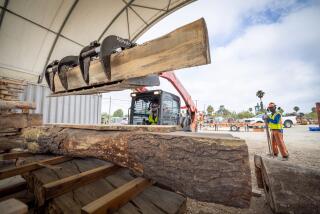Santa Fe May Find Timberland Buyers Are Scarce, Experts Say
- Share via
Santa Fe Southern Pacific may find it difficult to sell its Northern California forest products subsidiary because the market for timber acreage is glutted, industry experts say.
The Chicago-based railroad holding company announced Tuesday that it will try to sell Santa Fe Pacific Timber as part of a corporate restructuring. The Redding, Calif.-based subsidiary owns about 520,000 acres of timberland in 10 Northern California counties.
An estimated 8 million acres of the U.S. timber industry’s 68.8 million acres already is on the market, said Robert Slocum, vice president of the American Forest Council, an industry trade association. “Right now, it’s probably going to be difficult to move,” he added.
Buyers are scarce for large tracts of timberland, Mark Rogers, vice president and forest products analyst at Prudential-Bache Securities, said.
“Nobody pops into mind” as a potential buyer of Santa Fe Pacific Timber, he said. “There’s been a lot of timber for sale in the West for several years, and it’s still for sale.”
He added: “The business stinks--lumber, plywood are both in excess supply.”
Pacific Timber owns no mill or other manufacturing facilities, selling logs to mills in Oregon and Northern California, said Thomas Buckley, a spokesman for Santa Fe Southern Pacific. The wholly owned subsidiary holds three major timber tracts: 220,000 acres north of Lake Tahoe, 200,000 acres in the Shasta region north of Redding, and 100,000 acres between Grass Valley and Lake Tahoe.
None of the company’s lands are in the Coast Range, where logging has aroused complaints from environmentalists, Buckley said. The trees are mostly young and are not redwoods but Douglas firs, true firs, sugar pines and ponderosa pines. Federal government land grants in the late 1880s gave ownership of the forests to Southern Pacific Railroad, which merged with Santa Fe 3 1/2 years ago.
Southern Pacific tried to sell part of its forests near Lake Tahoe in 1981 and 1982, but withdrew them from the market when no buyer offered a price considered acceptable, Buckley said.
The spokesman declined to give an estimate of Pacific Timber’s sale price now or to identify possible buyers. President William F. Herbert refused to comment on the company’s sale.
Simpson Timber, based in Shelton, Wash., may be interested in buying Pacific Timber, John L. Walker, its vice president, said. “We’re not going to go after it aggressively, but we’re not going to let anybody steal it.”
Simpson’s interest will depend on the price at which Pacific Timber is put on the market, Walker said. He refused to say what he thinks the company is worth but added: “A lot of the sellers have expectations of what they can get based on the late 1970s, when everyone was real bullish on timber.”
Despite a recent improvement, prices for finished lumber and plywood products remain about half the 1979 peak after allowing for inflation, he added.
Santa Fe Southern Pacific sold its other timber business, Kirby Forest Industries, last December, Buckley said. Louisiana-Pacific, headquartered in Portland, Ore., paid $315 million for the subsidiary’s three lumber-processing plants, 553,500 acres of Texas timber and 99,100 acres of Louisiana timber, he said.
Wide variations in the quality and location of timber make it impossible to estimate the value of Pacific Timber’s forests from recent corporate deals, Prudential-Bache’s Rogers said.
Pacific Timber’s reported operating income was $17 million last year on revenue of $39.9 million, up from $13.7 million on $48.3 million in revenue in 1985. Santa Fe Southern Pacific lost $397.9 million last year because of a $914.1-million writeoff for railroad restructuring costs.
The holding company had hoped to merge Santa Fe and Southern Pacific--the two railroads it owns--but the Interstate Commerce Commission confirmed its rejection of that proposal Tuesday and ordered Santa Fe and Southern Pacific to submit a plan within 90 days for its divestment of at least one of the railroads.
More to Read
Inside the business of entertainment
The Wide Shot brings you news, analysis and insights on everything from streaming wars to production — and what it all means for the future.
You may occasionally receive promotional content from the Los Angeles Times.










